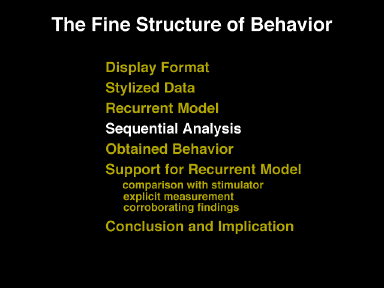 Slide 4-21
Slide 4-21

 Slide 4-21
Slide 4-21
Given the successful generation of the statistical properties of the behavior, we looked to see if any characteristics of the molecular behavior could be used to better predict the behavioral output.
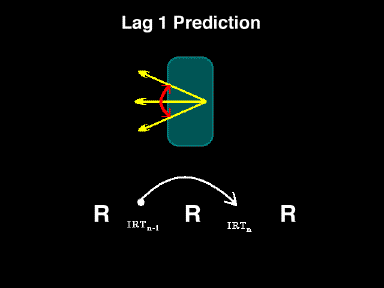 Slide 4-22
Slide 4-22
If we are trying to understand the determinants of the ebb and flow of behavior, we are trying to understand the factors which cause or which predict the spacing between individual instances of that behavior.
The first place to look for a determinant is the spacing of the immediately preceding response. Technically speaking, "is there a relationship between IRTn and IRTn-1?" If IRTn-1 is long for example, is there a greater or lesser likelihood that IRTn will have some specific value?
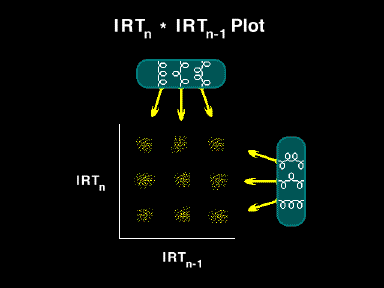 Slide 4-23
Slide 4-23
If behavior were totally homogeneous and there were no relationship between consecutive responses, then we would see an undifferentiated, relatively even cloud within the Cartesian space. Because responding virtually always occurs within three bands, the contingency space is nine clusters rather than one large cloud. Totally unpredictable or random alternations between the three bands would produce nine relatively even clusters representing the joint probabilities of an interresponse time in a particular band. If all were equally likely, then all clusters would be equally dense.
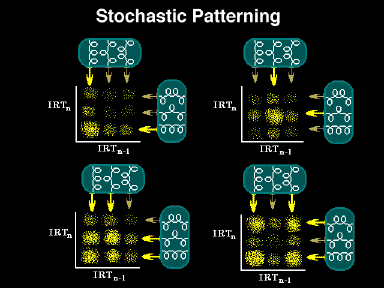 Slide 4-24
Slide 4-24
Even though these frames do not have homogeneous distributions of interresponse time, these frames show no evidence of anything more than a simple stochastic process. This is because all interresponse time bands are not equally likely. For example, the upper left frame shows a bird with 50% of its responding in the first or base band, and 25% in each of the others. The density of each of the nine clusters is the joint probability of that event; for example, 0.50 of 0.50; 0.50 of 0.25; or 0.25 of 0.25. The various densities in the four frames can be seen to be a function of the "crossing" of two identical distributions. They are always symmetrical around the main diagonal.
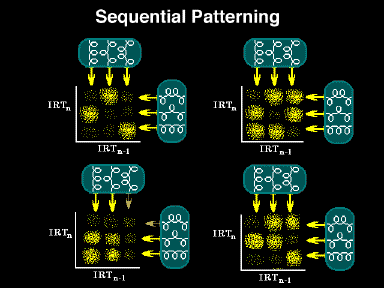 Slide 4-25
Slide 4-25
These frames illustrate examples of sequential patterns in the output of interresponse time. In these cases, interreinforcement time can be better predicted if the value of IRTn-1 is known. The highly probable or dense clusters are not simply a function of the joint probability of the interreinforcement time distributions. The upper left frame shows a situation where if IRTn-1 is in the first band, then the next interreinforcement time is more likely to be in the second band. A second band interreinforcement time is more likely to be followed by an interreinforcement time in the third band, and finally a third band interreinforcement time is most likely to be followed by one in the first band. The frame in the lower left corner illustrates a sequential pattern which extends across three consecutive interreinforcement times, but which is confounded when seen with respect to only the immediately preceding interreinforcement time. This frame illustrates double alternation, i.e., 11221122. An interreinforcement time in the first band is followed equally often by one in the first band and one in the second band, but they are not random. It demonstrates that as the sequential dependencies become more complex, the method of uncovering them becomes increasingly difficult.
 UNDER CONSTRUCTION
UNDER CONSTRUCTION
This frame provides an analytical procedure which could be used to resolve a third order pattern. It uses a three dimensional representation and it rotates it so that a pattern could be perceived even though the screen is only two dimensional. Even with this procedure there were no apparent non stochastic patterns in the behavioral output of pigeon.
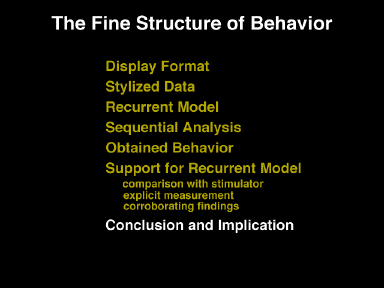 Slide 4-26
Slide 4-26
In summary.
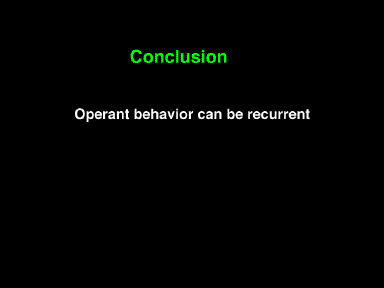 Slide 4-27
Slide 4-27
Key pecking in pigeon can be is a stochastic recurrent behavior. The important implications of these findings is.
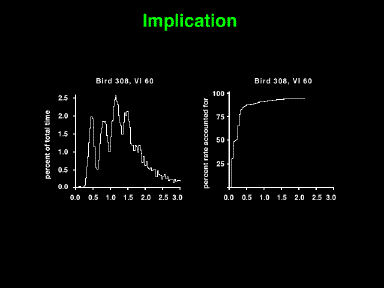 Slide 4-28
Slide 4-28
A substantial portion of the variation in our dependent variable (rate of key pecking) occurs in the recurrent portion of the behavior of pigeons. As a result it warrants further understanding.
Full text and figures of a journal article on this topic is available at:
***** DYNAMICS IN THE FINE STRUCTURE
OF SCHEDULE-CONTROLLED BEHAVIOR